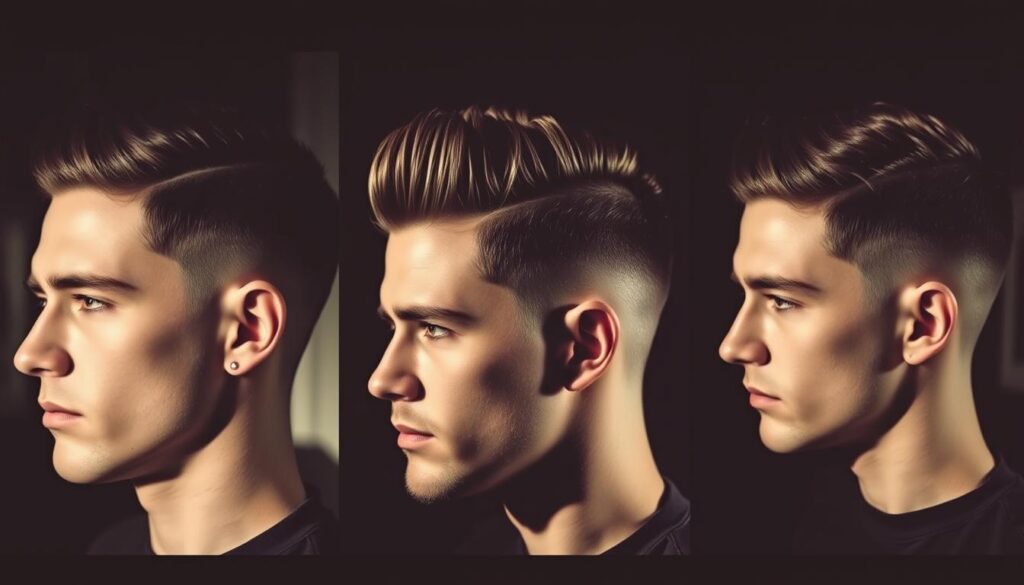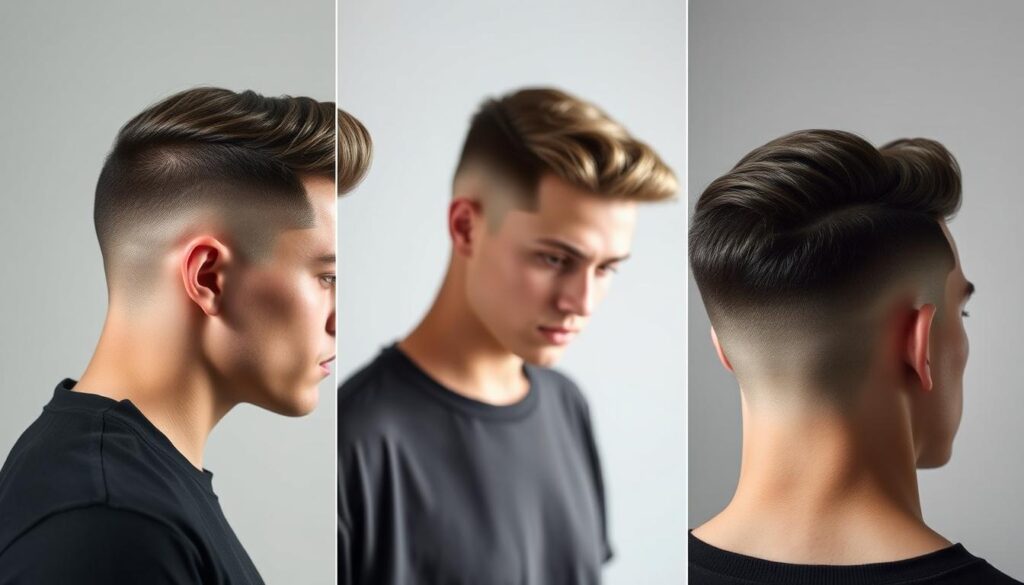
What if one haircut could redefine your entire look? For decades, the fade has dominated barbershop conversations and style magazines. But here’s the twist: this isn’t just another trend. It’s a masterclass in adaptability, blending sharp lines with natural flow to suit every face shape and personality.
Originally rooted in military grooming standards, today’s variations work for boardrooms and weekend hangouts alike. The magic lies in the gradient effect—shorter sides gradually merging into longer lengths on top. This creates clean edges without harsh contrasts, making it ideal for thick curls or straight hair.
Why do barbers call it the ultimate cut? Because it balances precision with personal flair. You can keep it subtle with a low taper or go bold with a high skin fade. Pair it with textured quiffs, slicked-back styles, or even buzz cuts. Your options are endless.
Key Takeaways
- Fades adapt to all hair textures and face shapes for universal appeal
- The gradient technique creates seamless transitions between lengths
- Works equally well in professional and casual settings
- Requires skilled blending for personalized results
- Evolved from practical military cuts to mainstream style staple
The Evolution and Appeal of Fade Haircuts

How did a military staple become a global style phenomenon? This cut’s journey from functional grooming to cultural powerhouse reveals why it remains barbers’ favorite canvas.
From Military Precision to Cultural Icon
In the 1940s, servicemen needed low-maintenance cuts that stayed sharp through weeks of duty. Barbers refined the buzz cut into a tapered masterpiece, blending practicality with crisp lines. The gradual length transition prevented jarring regrowth lines—a tactical advantage turned style innovation.
By the 1980s, urban barbers transformed this military relic into streetwear royalty. Hip-hop artists like Kid ‘n Play’s Christopher Reid showcased gravity-defying high-top versions. Neighborhood shops became laboratories for creative blends, proving fades could shout individuality as loudly as they whispered discipline.
| Decade | Development | Impact |
|---|---|---|
| 1940s | Military adaptation | Functional contrast |
| 1980s | Hip-hop reinvention | Cultural expression |
| 2000s | Global barber adoption | Style versatility |
Why This Classic Look Endures
Your hair gains chameleon-like power with fades. They frame angular jaws and soften round faces equally well. Modern barbers mix textures—think curly tops with skin-tight sides—creating looks that work for job interviews and concert nights.
The secret? Controlled rebellion. You keep professionalism at the office while hinting at creative edge. It’s why CEOs and skateboarders both nod approvingly at mirror reflections. This balance between tradition and trend explains its 80-year reign.
Exploring Popular Fade Types

Ever wondered how barbers create those perfectly blended looks? The secret lies in mastering gradient placement. Let’s break down the three foundational placements that form the backbone of modern men’s grooming.
Foundation Fades: Placement Matters
A low fade begins just above your ears. It maintains natural hair growth while creating subtle contrast. Perfect for corporate environments, it pairs well with side parts or comb-overs.
Move up to the mid fade starting at temple level. This midpoint option balances sharpness and softness. You get noticeable definition without overwhelming your facial features.
Choose the high fade for maximum impact. Starting above your temples, it leaves a striking band of longer hair on top. Ideal for textured crops or spiky styles, this cut demands attention.
Advanced Techniques for Bold Statements
Skin fades take tapering to the extreme. Your barber blends hair down to the scalp for razor-sharp edges. Combine this with a disconnected top for modern contrast.
The drop fade follows your hairline’s natural curve behind the ear. This creates a U-shaped silhouette that complements round face shapes beautifully. Pair it with curly tops for urban flair.
Specialty options like burst fades add artistic flair. These semicircular patterns around the ears work best with short hairstyles. Temple fades offer localized detailing for those wanting subtle edge.
Choosing the Right Fade for Your Face Shape and Hair Type
Your ideal cut acts like a tailored suit—it should enhance your best features while balancing proportions. Two factors determine your perfect match: the contours of your face and the behavior of your strands.
Understanding Your Face Shape
Round faces gain definition with higher placements. The gradual shortening from temples upward creates vertical lines, countering circular curves. Oval shapes? You’ve hit the genetic jackpot—nearly any gradient works.
Square jawlines thrive with high fades that emphasize angular bone structure. If your face leans long, keep the transition low near your ears. This horizontal emphasis prevents elongation.
Matching the Fade to Your Hair Texture
Thick locks handle dramatic contrasts beautifully. Mid or high options let dense strands command attention. Fine hair benefits from subtle low blends that add fullness without exposing scalp.
Curly crowns need strategic planning. Tighter coils stay manageable with clean sides, while longer tops showcase natural volume. The gradient becomes your secret weapon against bulkiness.
Your final choice merges geometry with biology. A skilled barber considers both your bone structure and hair behavior to craft proportions that feel custom-built. Remember: the right balance turns heads without shouting for attention.
Maintenance and Styling Tips for a Fresh Fade
How often should you visit the barber to keep that crisp edge? Your cut’s sharpness depends on smart upkeep. Follow these strategies to maintain clean lines and eye-catching contrast.
Regular Trims and At-Home Touch-Ups
Visit your barber every 2-3 weeks. This keeps transitions seamless and proportions balanced. Use clippers with adjustable guards for safe edge touch-ups between appointments.
Clean your tools after each use. Dull blades pull hair instead of cutting it. Always work with dry strands for precise trims.
Essential Styling Products for Your Look
Choose products that match your hair’s needs. Matte creams add texture without shine—perfect for natural styles. Sleek pomades create polished finishes for formal events.
| Product Type | Finish | Best For |
|---|---|---|
| Matte Cream | Natural | Curly/textured hair |
| Pomade | Shiny | Slicked-back looks |
| Texture Powder | Matte | Volume building |
| Sea Salt Spray | Beachy | Messy styles |
Apply products to damp hair for even distribution. Start with pea-sized amounts—you can always add more. Blow-dry longer tops upward to enhance height and movement.
Styling Inspirations: Trending Cuts and Custom Looks
Your hair becomes your signature when you pair bold contrasts with creative flair. Today’s top styles blend retro influences with razor-sharp precision, letting you showcase personality through strategic length play.
Integrating Longer Hair on Top with Sharp Sides
Combine longer hair top sections with tight sides for instant edge. The modern mullet revival uses burst taper techniques, curving sharply around the ear to highlight texture. Try a side part with mid fade—keep 3-4 inches on top for polished versatility.
For natural curls, let the crown flow freely while tapering near the scalp. This creates balance between wild texture and clean lines. Want drama? Pair a high taper with a textured mullet—voluminous back sections command attention.
Creative Variations to Express Your Personality
Break rules with a mohawk-inspired cut. Leave the center strip long and curve the sides back using a burst pattern. It’s rebellious yet refined, especially with matte styling products.
Drop fades create smooth arcs that flatter round faces. Team them with slicked-back tops or messy crops. For summer vibes, try a mid skin fade with beachy waves—salt spray adds effortless texture.
| Style | Key Features | Best For |
|---|---|---|
| Modern Mullet | Burst taper + textured back | Retro enthusiasts |
| Textured Mullet | High taper + voluminous top | Curly/wavy hair |
| Curly Contrast | Mid skin fade + natural crown | Office-to-bar transitions |
| Mohawk Edge | Burst mid fade + central strip | Bold statement seekers |
| Drop Fade | Rounded sides + versatile top | All face shapes |
Conclusion
Why do some styles remain timeless in a world of fleeting trends? For over eight decades, fade haircuts have proven their staying power in men’s grooming. They bridge generations and settings effortlessly—sharp enough for boardrooms yet edgy enough for weekend adventures.
Your choice in blending lengths reflects more than current fashion. It’s about finding that sweet spot between classic barbering techniques and modern self-expression. Whether you sport a subtle taper or bold contrast, the look adapts to your life’s rhythm without losing its core identity.
Age becomes irrelevant with these cuts. A clean mid-fade complements a 25-year-old’s textured crop as naturally as it enhances a 55-year-old’s polished comb-over. The secret lies in personalized gradients that flatter your features while maintaining professional appeal.
This isn’t just about looking good—it’s about crafting an image that evolves with you. With endless variations and expert blending, your cut becomes a signature rather than a template. That’s why these styles outlive trends: they’re not worn, they’re owned.
